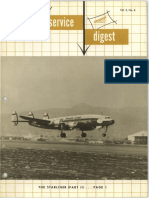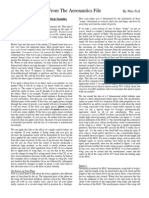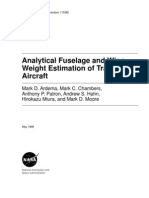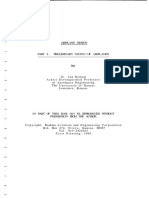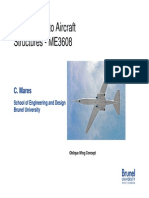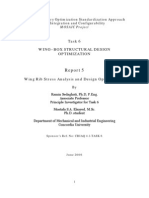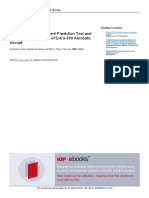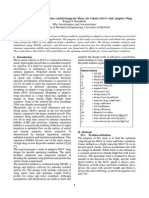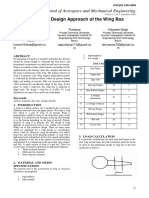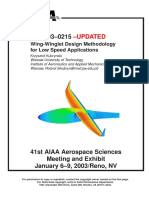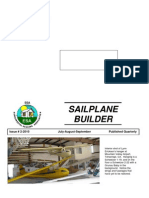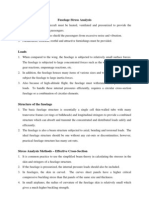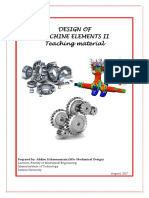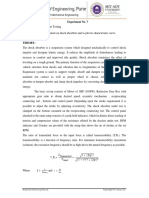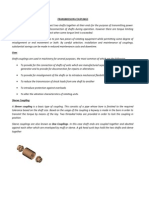Landing Gear Location
Landing Gear Location
Uploaded by
Jack AzadCopyright:
Available Formats
Landing Gear Location
Landing Gear Location
Uploaded by
Jack AzadOriginal Description:
Copyright
Available Formats
Share this document
Did you find this document useful?
Is this content inappropriate?
Copyright:
Available Formats
Landing Gear Location
Landing Gear Location
Uploaded by
Jack AzadCopyright:
Available Formats
14th National Conference on Machines and Mechanisms (NaCoMM09), NIT, Durgapur, India, December 17-18, 2009
NaCoMM-2009-TKAj2
Landing Gear Layout Design for Unmanned Aerial Vehicle
Akhilesh Jha SDET Division, ADE/DRDO, Bangalore, India Corresponding author (email: akhilsdet@yahoo.com)
landing gear system required for those UAVs, which has conventional take-off and landing.
Abstract
Aircraft landing gear mechanism serves several design purpose such as supporting the weight of aircraft, providing rolling chassis/taxiing and shock absorption function especially during takeoff and landing etc. The present study carried out to layout design of landing gear system for unmanned aerial vehicle (UAV) at conceptual design stage. The nose wheel tricycle landing gear has been the preferred configuration for UAV. The most attractive feature of this type of undercarriages is the improved stability during braking and ground maneuvers. The results of present study indicated that landing gear stability could be improved by longer wheel axle, stiffer damping mechanism and smaller wheel mass and lower aircraft sinking velocity. The present approach has been following the recommendations of the previous design of landing gear layout of other aircraft and international standard federal aviation regulations (FAR). More work to be done to prove the viability of this conceptual layout design. Detailed results needed further simulation study for validations. Keywords: UAV, Landing gear stability, Shock absorber, Tip back angle, Landing gear load factor.
1.2 Landing Gear
Landing gear system is a major component of every aircraft. The landing gear serves a triple purpose in providing a stable support for aircraft at rest on the ground, forming a suitable shock-absorbing device and acting as a rolling chassis for taxiing during manhandling. It is the mechanical system that absorbs landing and taxi loads as well as transmits part of these loads to the airframe so that a majority of impact energy is dissipated. The main functions of the landing gear are as follows: 1. Energy absorption 2. Braking 3. Taxi control The important types [1] of landing gear are as follows: 1. Tri-cycle type (nose gear in fuselage and main gear on wing) 2. Bicycle type (with or without outriggers) 3. Tail-gear type In above-mentioned types of landing gear arrangement, the tricycle type with nose gear in fuselage and main gear on wing also called nose wheel landing gear has a series of unquestioned advantages over other layout of landing gear. In a general sense, the analytical solution of UAVs landing gear layout has received very little attention. One reason for this neglect is that its very wider classification and applications. The traditional landing gear design process for transport aircraft has described in textbooks [1-4]. Therefore, in this paper nose wheel landing gear layout design for unmanned aerial vehicle has been described on basis of theoretical kinematics and international standard FAR.
Introduction
This section contains the basic definition, classification and function of unmanned aerial vehicle and landing gear systems.
1.1 Unmanned aerial vehicle
An unmanned aerial vehicle (UAV) commonly referred to is a remotely piloted aircraft. UAVs come in two class: some are controlled from a remote location and others fly autonomously based on pre-programmed flight. There is a wide variety of UAV shapes, sizes, configurations, and characteristics. UAVs perform a wide variety of functions. The majority of these functions are some form of remote sensing this is central to the reconnaissance role most UAVs fulfill, others functions include transport, research and development, to search for and rescue people in perilous locations etc. Nishant, Predator and Global hawk are importantly placed in the list of UAVs. The
2 Landing Gear Layout Design Parameters
This section represents a typical step by step approach that would be taken by the landing gear layout designer during conceptual design phase.
2.1 Main landing gear location
In the landing gear layout, the aircraft centre of gravity (c.g) location is needed to position the main landing gear such that ground stability, maneuverability and clearance requirements are met. The aerial vehicle has two
471
14th National Conference on Machines and Mechanisms (NaCoMM09), NIT, Durgapur, India, December 17-18, 2009 c.g positions, forward c.g. corresponding to full fuel mass at the time of take-off and the aft c.g. when fuel has been used or at the time of landing.
NaCoMM-2009-TKAj2
gear so that the appropriate level friction forces needed for steering can be generated. Nose gear loads in the static condition generally vary about 6-20%, but these should be considered as extremes. A preferable range would be 8% with the c.g aft, increasing to 15% with the c.g. forward has been considering in present design calculations.
Max static main gear load (per strut)
F-M = W (0.42-0.46)W 2F Max static nose gear load (3)
Fig. 1: Aerial vehicle with two c.g. positions. The position of aircraft c.g. can be obtained by knowing the component weight and their positions. Mean aerodynamic chord calculation (MAC) calculation based in Fig. (2) and Eqs. (1-2).
F-L = W (0.08-0.15)W F
(4)
Fig. 2: Half 2-D plan view of UAV for calculation of MAC.
2 MAC length (M) = 3 CR CT CR + CT C R +CT (1)
Fig.3: Diagram for Nose landing gear load calculation.
Min static nose gear load F-N = W (0.08)W F Max breaking nose gear load (5)
S (CR - M) H= (2) C R - CT The following steps are needed to position the main landing gear. 1a: Determination of mean aerodynamic chord of aircraft by using above Eqs. (1-2). 1b: Locate the forward and aft c.g. limit on the mean aerodynamic chord . 1c: Lines are drawn vertically from these forward and aft c.g. limits to locate the vertical position of the c.g. along these lines. 1d: Involves a recheck of the ensuing location of the main landing gear. It should be between about 50-55% of the MAC [2].
W = Max static load+ 10J (6) 32.2F Where W is the Take-off weight of aerial vehicle and other quantities are defined in Fig. (3). The equation (6) determines nose gear dynamic load, this is important for tire selection of landing gear [4].
2.3 Shock absorber stroke length calculation
The landing gears in most unmanned aircraft today are those making use of the solid steel spring or rubber and those making use of a fluid acting as spring with gas or oil, commonly known as the oleo-pneumatic landing gears. This technical paper has focused for conceptual layout design of oleo-pneumatic type shock absorber for both the main landing gears and the nose landing gear. The oleo-pneumatic shock absorber has been selected because it has the highest energy-dissipating efficiency among the various types of shock absorbers currently in use in the UAVs industry. It has efficiencies ranging as high as 0.7- 0.9. Based upon the required sink speeds and load factors, the vertical wheel travel must be determined. Normal
2.2 Load calculation on nose wheel and main wheel
The calculation of nose wheel and main wheel load are based on the diagram shown in Fig.(3) and the following as given relations and their constraints in Eqs. (3-5). The nose gear should be placed as far forward as to minimize its load, maximize flotation and maximize stability. Conversely, to allow for adequate nose wheel steering, a minimum normal force must act on the nose
472
14th National Conference on Machines and Mechanisms (NaCoMM09), NIT, Durgapur, India, December 17-18, 2009 design in which the wheel and strut travel the same distance. The first step is to determine the maximum loads accept able in the shock strut. This load comprises the static load plus the dynamic reaction load. When that load divided by the static load, the reaction factor N obtained. This is some time called to landing gear load factor or merely landing load factor. Its valued ranges from 2.03.0 for small utility aircraft or UAVs. Its permissible magnitude is determined by the airframe to accommodate those factors during landing impact. Initially, the aircraft is assumed a rigid body with no relative acceleration between the c.g. and gear attachment point. Thus, the load factor at the c.g. is the same as the attachment. To understand fully the relationship between the load factor at the center of gravity Nc.g and the landing gear load factor N, consider a free body being acted upon by shock strut forces and lift, as Shown in Fig. (4), Where Fs is the shock strut force and L, the lift. Thus Sum of all external forces Fs +L Nc.g = = (7) Mass M
NaCoMM-2009-TKAj2
Thus, for a given aircraft load factor, N will be higher for FAR Part23 aircraft than for FAR Part 25 aircraft. When the aircraft comes to rest on the ground, the lift is zero and the shock strut force is equal to the aircraft weight i.e. Fs =W Therefore
Nc.g =1+N for FAR part 23 Aircraft
The shock absorbers and tire act together to decelerate the UAVs from landing vertical velocity to zero vertical velocity. Therefore shock absorber and tire must also absorb the sum of the kinetic energy and potential energy of the aircraft; thus, Tire Strut Kinetic Potential Energy Energy Energy Energy
St n t NW + St n s NW = W V2 + 2g
( W-L ) (S+St )
(9) Where St = Tire deflection under N times static load, ft S = Vertical wheel travel, ft nt = Tire efficiency ns = Shock strut efficiency N = Reaction W = Aircraft weight L = Lift V = Sink speed
2.4 Lateral location of main gear
The tread and wheel base should to be determined. The relationship between the tread and wheel base is dictated by the turnover angle, which is determined as follows(Ref.Fig.5 ). (1) Draw a top view showing the desired nose most forward C.G location (2) Draw a side view showing the landing gear with shock absorbers and tire statically deflected and the C.G position.
Fig. 4 Shock strut dynamics When lift = weight W ( as specified in FAR part25 for transport- type aircraft*)
Fs L F + = s +g W M M g
If, for convenience, the landing gear load factor N is defined as being equal to Fs/Mass, the gear load factor determine how much load ,the gear passes to the airframe, which affects the airframe structural weight as well as strength. Then
Nc.g =1+N for FAR part 25 Aircraft
On utility and aerobatic aircraft, the rules of FAR part 23* apply and lift = 0.67w; i.e, W=l/0.67, as F 0.67 g Nc.g = s + L (8) M L
Fig. 5 Wheel track calculation based on turn over angle
473
14th National Conference on Machines and Mechanisms (NaCoMM09), NIT, Durgapur, India, December 17-18, 2009 (3) Establish line A-B Extend the line to a point C. (4)Through point, C draws a perpendicular to line A-B. (5) Through the c.g. (in the plane view draw a line parallel to A-B and obtain point D. (6)From point D measure height of the c.g. (H) obtained from the side view and obtain point E. = 63deg for aircraft that are restricted to operate on smooth, hard surfaced runways. This values is based on a side friction coefficient of = 0.55 and the assumption that the aircraft will slide sideways instead of tipping over. 11 12 13
NaCoMM-2009-TKAj2 0.74 m (7 cm max) 4.90 m (Approx)from nose 2.5
MAC Fwd C.G position Load factor
3.1 Load calculation
Nose gear loads calculation based on 8% with the c.g. aft, increasing to 15% with the c.g. forward. Max nose gear load = 2000x15/100 = 300kg Min nose gear load = 2000x8 /100 = 160 kg Main gear load (per strut) = 850kg and 920 kg
2.5 Tire selection
The tires are sized to be carried out the weight of the aircraft .Typically the main tires are carry about 90% of the total weight of the aircraft weight .Nose tires carry only about 10 % of the static load but experience higher dynamic loads during landing. In conceptual design stage we can find a tire size by using a statistical approach [3]. Given below equations developed from data for rapidly estimating main tire size (assuming that main tire carry about 90% of aircraft weight). These calculated values for diameter and width should increase about 30% if the aircraft is to operate from rough unpaved runways. Nose tires can be assumed to be about 60- 100% the size of main tire. Calculation of wheel diameter and width for main wheel Main wheels diameter or width (inch) =A WBW WW = weight on wheel. For general aviation aircraft, A=1.51, B = 0.349 for calculation of diameter A=0.715, B = 0.312 for calculation of width
3.2 Shock absorber stoke length calculation
For instance, let N =3, St =0.9 ft and V=15ft/s and assume 1 g wing lift such that L/W=1(at the time of landing ) Then stroke length calculation as given in eq.(9) 3(0.9 x 0.47 + S x 0.8) = 152 / 2 x 32.2 + (1-1) (S+0.9)
Stroke (S) = 11.10 inch
Table -2: Shock absorber stoke length Sink velocity (ft/s) Load factor (g load) 3 2.5 2.0 Stroke length (Inch) 11.10 7 5.3
3 Numerical Case Study
In this section we will discuss a case study of landing gear layout for following given dimensions Table -1: Landing gear layout case study parameters
1. 2. 3.
15 12 10
For an initial layout, assume that a quarter to a third of the total stroke is used in moving from static to compressed thus for a 11.10inch stroke,3.7 inch is the distance from static to compressed and 7.4 inch that from static to extended.
3.3 Nose landing gear position
1 2. 3. 4 5 6 7 8 9 10 Analysis Parameters Aircraft Take off weight Length of UAV Wing location Value 2000 kg 10 m (approx) The length of landing gear must be set so that the tail does not hit the ground on landing. This is measured from the wheel in the static position assuming an aircraft angle of attack (0 0.9) for landing which gives 90% of the maximum lift this range from about 3-8 deg for most types of aircraft. Another hand the tip back angle is the maximum aircraft nose up attitude with the tail touching the ground and strut fully extended. To prevent the aircraft from tipping on its tail, the angle off () the vertical from the main wheel position to the c.g. should be greater than the tip back angle or 15 deg whichever is larger. There is a rule-ofthumb which are correlate between alpha (0 0.9) and theta () as That is 0 = 0 0.9 + 30
3.5 m (L.E) from nose of UAV Wing span 21 m Root chord 0.975m Calculated Data MAC position 4.34 m C.G (vertical) 1.5m ( From ground) C.G shift 0. 10 times of MAC length Tip chord 0.5 m Aft C.G location 5.0 m from nose
474
14th National Conference on Machines and Mechanisms (NaCoMM09), NIT, Durgapur, India, December 17-18, 2009 At conceptual design stage we have taken a range ( 30-80 ) of value alpha (0 0.9 )which are feasible for this solution than corresponding value of thita ( ) in that range is (60 110) With known value of vertical c.g. height (H) from the level ground so corresponding (M) distance between Aft c.g. to main wheel position horizontally as shown previous Fig.6.
NaCoMM-2009-TKAj2
For a given parameters C.G height H = 1.5 approx and value of D = 2.7 m and wheel base = 3 m From given geometry in Fig. 5, we can calculate wheel track as given Tan = H / K, Where CD =K ,Then
Tan50 = 1.5/K => K = 1.3 There fore sin = K / D ( where D = 2.7 m) Now Tan = Z / F => Z = tan 28 X F => = 28 deg
=> Z = 0.53 x3 => Z =1.53 m (F =4.115 m) Fig. 6 Tricycle landing gear geometry Suppose as ideal value 0 0.9 is 6 deg than corresponding value of is 9 deg an nose wheel carry 10% of MTOW than wheelbase can be calculated as So value of M = H tan () => 1.5 tan 90 = 0.237 m (where value of H = 1.5m approx) Load on nose wheel is 200 and corresponding load main wheel 900kg Take moment about nose wheel Max static main gear load (per strut) = W (F-M)/2F, where F is wheel base in meter => 900= 2000 (F-M) /2F F = 10X.0.237 = 2.4m We have calculated the wheel track for the turnover angle range from 45 deg to 55 deg wheel track = 2 Z =2x1.53 = 3.2m For a given wheel base F= 3m, M =2.37m, for different turnover angle wheel track as below Table- 3: Wheel track corresponding given wheelbase
3.5 Tire sizing
Calculation of wheel diameter and width for main wheel. For general aviation aircraft and UAVs, A=1.51, B = 0.349 for calculation of diameter [4]. D =AWBw for diameter calculation, wheel of main landing gear = 1000 kg
Table- 2: Wheelbase corresponding given turnover Angle
max load per
Use log both sides logD = log A+ B log Ww � logD = log1.51 + 0.349 log 920
D = 16.40 in
Tire dia range from (14-16.40 in ) Similar way for width (T) calculation of main wheel T = AWBw, By using log both sides, log T = log A +B log Ww Log T = log0.7150 +0.312 log 1000 kg
3.4 Lateral location of main landing gear
Calculation of lateral location of main landing gear, which is, depends upon turnover angle and C.G height. For a given C.G height, we can calculate the lateral location of main landing gear in a given feasible range of turnover angle. The turn over angle must not be more 63 deg for typical UAV to operate on smooth, hard surfaced runways. We can calculate the lateral separation of landing gear
Tire width (5.0-6.1in)
Calculation of tire diameter for nose wheel where nose wheel total (static +dynamic) Max load 650 kg (including 7% margin of safety) Nose wheel tire can be assumed to be about 60- 100% the size of the main wheel tires. Nose wheel tire detail tire size 13-16 in and tire width is around 4-6 in.
475
14th National Conference on Machines and Mechanisms (NaCoMM09), NIT, Durgapur, India, December 17-18, 2009
NaCoMM-2009-TKAj2
4.0 Results and Discussion
The results of the study also indicated that landing gear stability could be improved by longer wheel axle, smaller wheel mass and lower aircraft velocity. The nose wheel tricycle gear has been the preferred configuration for UAV. It leads to a nearly level fuselage when the aircraft is on the ground, important for payload safety. The most attractive feature of this type of undercarriages is the improved stability during braking and ground maneuvers. Under normal landing attitude, the relative location of the main assembly to the aircraft cg produces a nose-down pitching moment upon touchdown. This moment helps to reduce the angle of attack of the aircraft and thus the lift generated by the wing.
quirement. While the shock absorber stroke is not a function of the aircraft weight, nevertheless it is vital to increase the size of the stroke to lower the landing load factors and thereby minimizing the structure weight due to landing loads. To accommodate this requirement, larger-section tires can be utilized. However, the penalty for this solution is the increase in aircraft weight and therefore reduced payload that would be too costly for UAVs.
5 Concluding Remark
Based on present study of landing gear layout design of UAVs the following concluding remark are drawn. Nose gear loads in the static position preferable or optimum range would be 8-12%. The wheel track of landing gear is approximately 25-30 % of wing span in UAVs cases. The stroke length of oleo pneumatic shock absorber is approximately equal to touchdown sink speed. The strut length is about 2.5 to 3.0 times the stroke length. Nose wheel diameter is 60-100 % of main wheel dim in nose wheel landing gear. Many more options could be decided to functionally and operationally improve the present conceptual design by using various computer simulation programs. These results needed experimental data to validate it.
5 4.5 4 3.5 3 2.5 2 1.5 1 2.5 3.5
Wheel Base
8% MT Ow on Nose wheel 9% MT OW on Nose wheel 10% MT OW on Nose Wheel 11% MT OW on Nose wheel 12% MT OW on Nose wheel
4.5
CL Max Angle
5.5
6.5
7.5
8.5
Fig. 7: Nose wheel Vs wheel base at constant angle
30 25
References
L.G.F =2.5g L.G.F =3g L.G.F=2g
Stroke Length
20 15 10 5 0 7.5 10
[1] Roskam(1986), Airplane design part IV: Layout design of landing gear systems, Roskam aviation and engineering corporations [2]Currey (1988). Aircraft Landing Gear Design: Principles and Practices 1st Edition, American Institute of Aeronautics and Astronautics.
Sinking Velocity
12.5
15
17.5
[3]H.G Conway, Landing gear design, The Royal Aeronautical Society Chapman and Hall Ltd, 1958. [4]Daniel P. Raymer (1992). Aircraft Design: A Conceptual Approach 1st Edition, American Institute of Aeronautics and Astronautics, Inc, p229-256. [5] Joseph E. Shigley (1977). Mechanical Engineering Design 3rd Edition, McGraw Hill, Inc., p26, 34, 37-40, 43-45, 60, 94-120, 295-313. [6]Department of Transportation, Federal Aviation Administration (1976). Airframe and Power plant Mechanics Airframe Handbook Revised 1st Edition, Aviation Maintenance Publishers, Inc., p341-405. [7].Young ,D,E., Aircraft landing gears-The past, present and future, proceedings of the institute of mechanical engineers,vol 200,noD2,1986,pp. 75-92. [8]S.F.N Jenkins, Landing Gear Design and Development, Proc. Instn. Mech. Engrs. Vol. 203, pp. 67-73.
Fig. 8: Sink speed Vs vertical wheel travel
19 17 15 13 11 9 7 5 3 1
Sinking velocity=10fps Sinking Velocity =11 fps Sinking velocity = 9fps
Stroke Length
1.5 2 2.5 Landing Gear Load Factor
3.5
Fig. 9: Vertical wheel travel Vs load factor In addition, the braking forces, which act behind the aircraft c,g., have a stabilizing effect and thus enable the external pilot to make full use of the brakes. These factors all contribute to a shorter landing field length re-
476
You might also like
- Hand Operated Can CrusherDocument60 pagesHand Operated Can CrusherParen Trivedi100% (2)
- 6 Spd. Manual Transmission 01E All Wheel DriveDocument554 pages6 Spd. Manual Transmission 01E All Wheel DriveNPNo ratings yet
- The Design and Construction of Flying Model AircraftFrom EverandThe Design and Construction of Flying Model AircraftRating: 5 out of 5 stars5/5 (2)
- Pega Stol Wing Kit Wing Stress AnalysisDocument39 pagesPega Stol Wing Kit Wing Stress Analysislaerciofilho100% (2)
- Aircraft Structures DJpeery PDFDocument464 pagesAircraft Structures DJpeery PDFCarmen Alicia RbNo ratings yet
- TL 1.15 Example Aircraft Loading CalculationsDocument22 pagesTL 1.15 Example Aircraft Loading Calculationsachyutha_krishnaNo ratings yet
- Propeller Aerodynamics: The History, Aerodynamics & Operation of Aircraft PropellersFrom EverandPropeller Aerodynamics: The History, Aerodynamics & Operation of Aircraft PropellersRating: 4.5 out of 5 stars4.5/5 (3)
- Unconventional Aircraft ConceptsDocument172 pagesUnconventional Aircraft ConceptsJack Azad100% (4)
- MV Agusta 910 Engine Workshop ManualDocument112 pagesMV Agusta 910 Engine Workshop Manualwi$ard100% (1)
- Lockheed Field Service Digest FSD Vol.3 No.6 Intro L1649 Starliner Part 2 of 3Document32 pagesLockheed Field Service Digest FSD Vol.3 No.6 Intro L1649 Starliner Part 2 of 3arizonaflyer50% (2)
- Specifications of 1250Tcd Sulphitation Sugar Plant Expandable To 2000 TCDDocument73 pagesSpecifications of 1250Tcd Sulphitation Sugar Plant Expandable To 2000 TCDAHmad NaqashNo ratings yet
- Small Unmanned Aircraft: Theory and PracticeFrom EverandSmall Unmanned Aircraft: Theory and PracticeRating: 4.5 out of 5 stars4.5/5 (2)
- Aerodynamic Optimization of Subsonic Flying Wing ConfigurationsDocument7 pagesAerodynamic Optimization of Subsonic Flying Wing ConfigurationsPrince UzumakiuNo ratings yet
- Pitch StabilityDocument6 pagesPitch StabilityAirPlaneTrainMobileNo ratings yet
- Calculation of Wing LoadsDocument55 pagesCalculation of Wing LoadsJony Oliver Lazo Ramos100% (1)
- Design of An Aircraft Wing Structure For Static Analysis and Fatigue LifeDocument5 pagesDesign of An Aircraft Wing Structure For Static Analysis and Fatigue Lifeankitsinghal54No ratings yet
- Endurance GliderDocument16 pagesEndurance Gliderumunera2997100% (1)
- Wing Finite Element Analysis1Document16 pagesWing Finite Element Analysis1usakalambaNo ratings yet
- Analytic Wing and FuselageDocument55 pagesAnalytic Wing and FuselageJack100% (2)
- Canards - Design With CareDocument3 pagesCanards - Design With CareMark Evan Salutin100% (1)
- Finite Element Analysis of Aircraft Wing Using Composite StructureDocument7 pagesFinite Element Analysis of Aircraft Wing Using Composite StructureMuHaZir100% (1)
- Manufacturing and Struct. Analysis of A UAVDocument129 pagesManufacturing and Struct. Analysis of A UAVsaifchi555No ratings yet
- Schrenks MethodDocument50 pagesSchrenks MethodMukesh KarunanethyNo ratings yet
- Airplane DesignDocument216 pagesAirplane DesignPHÚC Lê Mai Hoàng100% (1)
- Design and Stress Analysis of Aircraft StructureDocument33 pagesDesign and Stress Analysis of Aircraft StructureKugan Kugan MadiwananNo ratings yet
- Aircraft Wing Rib DesigningDocument97 pagesAircraft Wing Rib DesigningNagaraj Ramachandrappa100% (1)
- Wing Rib Analysis Shear Center For 3 Stringer Closed CellDocument33 pagesWing Rib Analysis Shear Center For 3 Stringer Closed Cellpramodssg100% (1)
- ME3608 Aeroelasticity #1Document31 pagesME3608 Aeroelasticity #1djtj89No ratings yet
- Aircraft Design Project 2Document117 pagesAircraft Design Project 2Mahesh J Rao85% (13)
- Aircraft Engine Attachment and Vibration ControlDocument8 pagesAircraft Engine Attachment and Vibration ControlSivaramanNo ratings yet
- Shear Force and Bending Moment Diagrams Due To Loads Along Chordwise DirectionDocument11 pagesShear Force and Bending Moment Diagrams Due To Loads Along Chordwise DirectionERÃŋkîtÇhàñdràkàr100% (1)
- Aircraft Design Day6Document39 pagesAircraft Design Day6arun_sanga1233515100% (2)
- WINGDocument94 pagesWINGRaj Manova100% (1)
- Wing Rib Stress Analysis and Design OptimizationDocument5 pagesWing Rib Stress Analysis and Design OptimizationNeeraja ManemNo ratings yet
- Wing Rib Stress Analysis and Design OptimizationDocument90 pagesWing Rib Stress Analysis and Design Optimizationsrikanthlaxminrayan586975% (4)
- Wing Layout DesignDocument12 pagesWing Layout DesignVanCarotNo ratings yet
- Hinge Moment Theoretical CalculationDocument13 pagesHinge Moment Theoretical CalculationArmghan ShabirNo ratings yet
- Aermacchi Landing GearDocument10 pagesAermacchi Landing GearRahman Ehvan100% (2)
- Strength Analysis of Air Plane WingDocument96 pagesStrength Analysis of Air Plane WingAlwin Tharakan67% (3)
- Aerodynamics Design AssignmentDocument11 pagesAerodynamics Design AssignmentRanggi Sahmura100% (1)
- Simulation of Aircraft Landing Gear Dynamics Using Flexible MultibodyDocument10 pagesSimulation of Aircraft Landing Gear Dynamics Using Flexible MultibodyElvindinata100% (2)
- Preliminary Design Approach of The Wing BoxDocument3 pagesPreliminary Design Approach of The Wing BoxWhyDirgantara IDNo ratings yet
- Stability and Control: Outline of This ChapterDocument21 pagesStability and Control: Outline of This ChaptergarridolopezNo ratings yet
- Wing-Winglet Design Methodology For Low Speed ApplicationsDocument10 pagesWing-Winglet Design Methodology For Low Speed ApplicationsThiago Lins CostaNo ratings yet
- Aircraft StabilityDocument126 pagesAircraft StabilitymunirnadirNo ratings yet
- The Role of Drag Prediction in Combat Aircraft Design and DevelopmentDocument6 pagesThe Role of Drag Prediction in Combat Aircraft Design and DevelopmentLeiser HartbeckNo ratings yet
- Wagar: Manoeuvring AerodynamicsDocument287 pagesWagar: Manoeuvring AerodynamicsdavpaffNo ratings yet
- 100 Years of SailplanesDocument24 pages100 Years of SailplanesEric RaymondNo ratings yet
- ABOTT Summary of Airfoil DataDocument266 pagesABOTT Summary of Airfoil Datapilotazprz100% (2)
- Design and AnalysisDocument9 pagesDesign and Analysisiaset123No ratings yet
- 2010sep Sailplane BuilderDocument12 pages2010sep Sailplane BuilderFelix ThePony100% (1)
- Naca AccDocument62 pagesNaca AccShear Wind100% (1)
- Wing Flutter Analysis2Document23 pagesWing Flutter Analysis2Muthu VelNo ratings yet
- Fuselage Stress AnalysisDocument3 pagesFuselage Stress Analysisbenandbergen100% (4)
- Northrop N-63 Convoy Fighter: The Naval VTOL Turboprop Tailsitter Project of 1950From EverandNorthrop N-63 Convoy Fighter: The Naval VTOL Turboprop Tailsitter Project of 1950Rating: 5 out of 5 stars5/5 (2)
- Modeling the Effect of Damage in Composite Structures: Simplified ApproachesFrom EverandModeling the Effect of Damage in Composite Structures: Simplified ApproachesNo ratings yet
- A Much Unsung Hero, The Lunar Landing Training Vehicle: And Other NASA RecollectionsFrom EverandA Much Unsung Hero, The Lunar Landing Training Vehicle: And Other NASA RecollectionsRating: 5 out of 5 stars5/5 (1)
- Unconventional Aircraft Design MITDocument119 pagesUnconventional Aircraft Design MITJack AzadNo ratings yet
- Design and Computational Analysis PDFDocument143 pagesDesign and Computational Analysis PDFJack AzadNo ratings yet
- Taxilian Wings Final Design Report PDFDocument33 pagesTaxilian Wings Final Design Report PDFAisha ChaudharyNo ratings yet
- Aerodynamic Modeling of A Membrane WingDocument236 pagesAerodynamic Modeling of A Membrane Wingmatthew_6No ratings yet
- Conceptual Design of A Ducted FN UAVDocument10 pagesConceptual Design of A Ducted FN UAVJack AzadNo ratings yet
- 0408 PDFDocument258 pages0408 PDFRisgam PutraNo ratings yet
- Light Electric Vehicle One Passenger 14mph 21Document18 pagesLight Electric Vehicle One Passenger 14mph 21Jack AzadNo ratings yet
- 06 ATA29 Hydraulics 2012Document17 pages06 ATA29 Hydraulics 2012Jack Azad100% (1)
- RC Hovercraft Customized Remote ControlDocument16 pagesRC Hovercraft Customized Remote ControlJack AzadNo ratings yet
- 03 ATA24 Electrics 2012Document25 pages03 ATA24 Electrics 2012Jack Azad100% (1)
- Calculation Design Duct Ed FanDocument15 pagesCalculation Design Duct Ed FanJennyparisNo ratings yet
- Ultra and Very Light Ducted Fan PropulsionDocument10 pagesUltra and Very Light Ducted Fan PropulsionJack Azad100% (2)
- MECA 322 - Sample Questions 1Document5 pagesMECA 322 - Sample Questions 1Arda GunayNo ratings yet
- Proposal Instrumentation Peusangan RevYRDocument24 pagesProposal Instrumentation Peusangan RevYRYudi R PutraNo ratings yet
- Operating Manual: For Electric Motor / Gear MotorDocument46 pagesOperating Manual: For Electric Motor / Gear MotorPablo Hidalgo Valenzuela100% (1)
- Ape Auto HT DX EnglishDocument3 pagesApe Auto HT DX EnglishDebasis PandaNo ratings yet
- 400cc (LT-A400F AK46K 2003-2006) Suzuki ATV Parts ListDocument71 pages400cc (LT-A400F AK46K 2003-2006) Suzuki ATV Parts ListMarkNo ratings yet
- Machine Elements 2 Course MaterialDocument163 pagesMachine Elements 2 Course Materialbontu gadisaNo ratings yet
- Rex Miller, Mark R. Miller - Robots and Robotics - Principles, Systems, and Industrial Applications (2017, McGraw-Hill Education) - Libgen - LiDocument518 pagesRex Miller, Mark R. Miller - Robots and Robotics - Principles, Systems, and Industrial Applications (2017, McGraw-Hill Education) - Libgen - Liabhishek thoteNo ratings yet
- Caterpillar Cat 326D2 L Excavator (Prefix REC) Service Repair Manual (REC00001 and Up)Document28 pagesCaterpillar Cat 326D2 L Excavator (Prefix REC) Service Repair Manual (REC00001 and Up)kfm8seuudu0% (1)
- High-Torque, All-Hydraulic Auger DrillDocument2 pagesHigh-Torque, All-Hydraulic Auger DrillAsif KhanzadaNo ratings yet
- Expt 7 Shock Absorber Test RigDocument5 pagesExpt 7 Shock Absorber Test RigRithwik pawarNo ratings yet
- TM 9-1786B Power Train, Track Suspension and Equipment For 13-Ton High Speed Tractor M5 1944Document298 pagesTM 9-1786B Power Train, Track Suspension and Equipment For 13-Ton High Speed Tractor M5 1944beppefranz100% (1)
- Penstocks DesignDocument36 pagesPenstocks DesignTaher Mohiuddin100% (1)
- Research Article Design of A Manual Table-Top Grinder (Mattog)Document5 pagesResearch Article Design of A Manual Table-Top Grinder (Mattog)Chinedum MgbemenaNo ratings yet
- Workshop Manual Newage 85m2 GearboxesDocument15 pagesWorkshop Manual Newage 85m2 Gearboxesdjordjes123No ratings yet
- SINOPEC Industrial CatalogueDocument12 pagesSINOPEC Industrial CatalogueSumaya Akter0% (1)
- Gear RatiosDocument2 pagesGear RatiosNagu SriramaNo ratings yet
- (1970) Optimal Synthesis Problems Solved by Means of Nonlinear Programming and Random MethodsDocument23 pages(1970) Optimal Synthesis Problems Solved by Means of Nonlinear Programming and Random MethodsJONATHAN JUSTINO APOS CASSIMIRONo ratings yet
- CouplingDocument5 pagesCouplingAnonymous 0v9zwXz6hFNo ratings yet
- Catalogo Solo CBN Serie 3000Document230 pagesCatalogo Solo CBN Serie 3000LEONARDO DIAZNo ratings yet
- Manual de Partes - Platina 125 - Boxer 125Document68 pagesManual de Partes - Platina 125 - Boxer 125Jhony Jheferson Lopez PizarroNo ratings yet
- Centrifugal PumpsDocument48 pagesCentrifugal PumpsDevendra BangarNo ratings yet
- ARBDocument80 pagesARBAnonymous lfw4mfCmNo ratings yet
- MNLCBKR200Document5 pagesMNLCBKR200michalickapatrik6No ratings yet
- Noblelft FD20-35 Operation & Maintenance ManualDocument176 pagesNoblelft FD20-35 Operation & Maintenance ManualamonNo ratings yet
- Gear Wheels and Gear Cutting 1977 PDFDocument100 pagesGear Wheels and Gear Cutting 1977 PDFhawktripNo ratings yet









